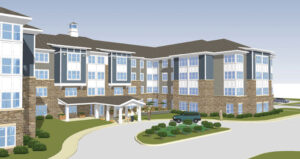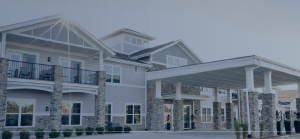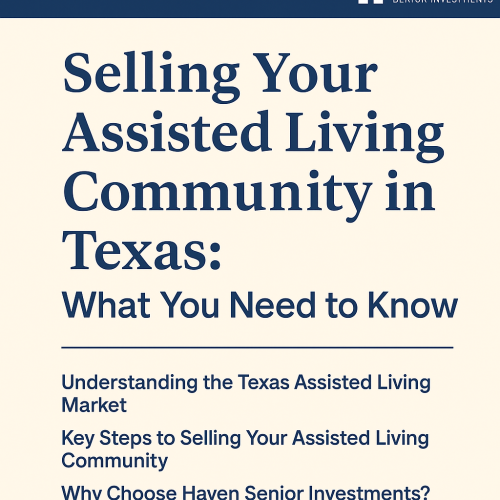Let’s stop talking about senior housing as only for “old people.”
Yes, there are about 55 million senior citizens (ages 65 and over) living in the United States, with this number expected to rise to more than 85 million by 2050. Yes, roughly between 5 percent to 10 percent of adults aged 65 or older require daily medical assistance or are receiving government financial aid, but what about the rest? Over the past two years, much of the dialogue (including from us at CCG) related to the shortage of senior housing has focused on two segments of the population—the less healthy and the less affluent. But, you know what? According to a study published in the JAMA Internal Medicine, around half of seniors ages 65 and over reported their health as “excellent” or “very good”; yet not this entire population want to own their own home anymore. So, where do they live? If you know a thing or two about private-pay senior housing, then you are probably familiar with housing options such as Independent Living, Assisted Living, Skilled Nursing and Memory Care. These forms of senior housing have attracted capital and resident attention for at least the past several decades. But there is something exciting taking hold within the senior housing market—it’s called Active Adult Living (AAL).
What is Active Adult Living and how does it fit in?
AAL sits in the grey area between traditional multifamily housing and independent living. It doesn’t really compete with either product as the alternative to AAL tends to be seniors who are choosing to stay in their homes. The AAL apartment renter is resistant to conventional senior living and has no interest in “living with a bunch of old people”. They are active, healthy and don’t need a meal plan. They want to enjoy their active years in an environment that is highly amenitized, supports their interests and offers a community ambience, conducive to building and sustaining new friendships. They just don’t want to deal with maintenance and taking care of a house anymore—they’ve got things to do, places to go…
Active adult living is growing in popularity and has generated a lot of investor buzz. In CBRE’s 2021 Senior Housing Investor Survey, 31 percent of respondents voted AAL as senior housing’s biggest opportunity for investment interest, receiving the highest percentage of votes. Interestingly, it is a term that is still without agreement as to a universal definition. In the absence of consensus, we will call it a niche senior housing product that is still working out its kinks. What we do know is that, at their core, AAL communities are highly amenitized rental apartment communities for healthy seniors—typically at least 55 years old.
Beyond our simple definition, we can also chip away at what it covers by looking at what’s driving demand. The growing demand for AAL communities is driven by similar motivations that drove millennial apartment demand over the past decade—a desire to live in a walkable, amenity-rich, transit-oriented location that is close to retail, dining and entertainment. Not surprisingly, these communities have all kinds of amenities, running the gamut from 24-hour on-site staff, recreational facilities and social activity programming by professional staff, grounds maintenance, transportation services, and home maintenance (but no housekeeping). Beyond being a place to live for people of a similar age, an important and distinguishing characteristic of these communities is the programming and scheduled activities, including book clubs, exercise classes, group hikes and yoga classes to name a few. It is called ‘active” adult living for a reason—because the programming plan is set with that purpose in mind. Cool social gathering places are also important, movies theaters and interestingly, gym access rank high too. Keep an eye out for an on-site beauty and barber shop; and dining / bistro lounges too. Throw in a greenhouse or two and you get the picture.
The AAL investor economics
Getting the right amenities package, apartment finishes, staffing and location combined with matched demographics presents many challenges. Defining the parameters is no easy task. Even if an investor gets that right, the next challenge is how to brand it, price it and iron out key metrics to measure performance. Seniors control the vast majority of the wealth in the United States but are typically cautious with their spending and are uncomfortable paying for add-ons they don’t really need. Then there is the issue that seniors (who don’t particularly enjoy being called a senior), just like other age brackets, aren’t homogenous. A 55-year-old senior has very different interests than a 75-year-old senior and so on. How do you solve for both? Seniors want a living environment that can adapt to their changing wants and needs. One way to address it is to offer a menu of amenities and price accordingly. But what about the basic rent starting point—should it be a premium or discount to multifamily apartments and/or independent living apartments (or something else entirely)? Industry feedback we have collected has AAL apartment rents largely trending higher by anywhere between 10 percent-30 percent relative to traditional multifamily rents, and a significant premium on rent for typical independent living communities. We did some checking on a few websites, and what we found was AAL apartments were going for anywhere between $1,200 to $4,750 per month, depending on location and amenities package. Basic versus lavish; there is something for any “senior” to explore.
What about the property-level P&L? If coming at AAL from a multifamily investor perspective, the lease pro formas look a lot different. AAL communities take a lot longer to lease up, but an operator can charge more, and the retention is higher, with the average resident remaining for six to eight years on average while traditional assisted living sees only an average of two years A large player in the space, The Carlyle Group, has reiterated this message, saying that for its product, the average lengths of stay are more than two times the average of independent living and at profit margins that outperform traditional senior housing. It argues that having a stable, consistent tenant base allows investors to push rent growth, which translates to higher, more consistent returns. The Carlyle Group works with several partners in the space, including Greystar on its Overture brand. According to its website, Greystar manages 56 AAL communities with over 10,700 apartments and has recently launched a middle market brand focused on a lower price point and has adjusted amenities accordingly. Greystar and The Carlyle Group aren’t the only institutions focused on this new niche, as we continue to see more developers and investors moving into this growing space. Just in the last few weeks, by example, Avenue Development announced the launch of their new AAL company, Viva Bene, focused exclusively on this concept. Bain Capital Real Estate closed their $3 billion fund at the end of last year that includes active adult living as a sub-strategy. Welltower announced a joint-venture in the U.K. focused on the “next generation” of senior housing, with AAL being a top priority. As capital is beginning to flow into AAL, we only see an increase in allocation and attention on this niche going forward.
From a pricing perspective, AAL cap rates tend to be all over the board (which seems consistent with the lack of clarity of the sector, in general) but it appears they trend lower than senior housing counterparts but on-par or higher to multifamily cap rates. This presents investors with an interesting question—do they view AAL as a niche falling in with multifamily or senior housing? That answer doesn’t seem to be quite clear if cap rate trends are supposed to be a guide. Clarity of product type may be a driving factor for investors in recognizing the opportunity for capital allocation.
So where does all this leave us?
Well, we know there is a senior housing shortage, and we know that seniors aren’t that much different from millennials in many respects. We also know that this product is on the move and growing in investor attention and focus. At CCG, we prioritize the importance of innovation and recognizing new opportunities before they have already reached their inflection point. We believe AAL is not just a way of doing old things new ways but is a new, new thing. With what we have seen from these community offerings so far—when can we move in?
Deborah Smith is co-founder and CEO of The CenterCap Group. The CenterCap Group, LLC is a boutique investment bank providing strategic advisory, capital-raising and consulting related services to private and public sector companies and fund managers across the real assets industry.






